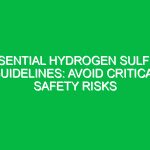“`html
Essential Hydrogen (H2S) Sulphide Safety Guidelines You Must Know
Good morning team,
Today, we’re going to talk about a critical topic that affects our safety and well-being on the job: Essential Hydrogen Sulphide (H2S) Safety Guidelines. Understanding and implementing these safety guidelines is crucial in preventing workplace accidents and ensuring a safe working Environment for all of us.
Hydrogen Sulphide, or H2S, is a colorless gas known for its distinctive rotten egg smell. Although it might seem harmless in small amounts, it can pose serious health risks, and understanding these risks is vital in our operations. Let’s dive into the essential safety guidelines you must know!
Understanding Hydrogen Sulphide (H2S)
What is Hydrogen Sulphide?
Hydrogen Sulphide (H2S) is a highly toxic gas that can be produced during various industrial processes, especially in oil and gas operations, sewage treatment, and mining. It is critical to recognize that inhaling H2S can lead to serious health consequences, including respiratory distress and even death in high concentrations.
The Importance of H2S Safety
H2S safety is a fundamental part of our work culture, as exposure to this gas can have immediate and long-term health Effects on employees. Understanding H2S and its associated risks allows us to take proactive measures to mitigate them, ensuring that everyone goes home safe at the end of the day.
Common Misconceptions
One common misconception is that because H2S has a distinctive odor at low concentrations, we can rely on our sense of smell to detect it. However, this is misleading; at higher concentrations, H2S can quickly numb the sense of smell, preventing detection and leading to dangerous situations. Therefore, it is essential to use proper detection equipment and follow safety guidelines at all times.
Key Hazards, Risks, and Safety Considerations
Identifying the Hazards
H2S can be encountered in various forms, and identifying the hazards associated with it is crucial:
- Inhalation Risk: Inhaling H2S can lead to irritation of the eyes, nose, and throat, and in severe cases, can cause loss of consciousness.
- Flammability: H2S is flammable and can form explosive mixtures with air. A spark or flame could lead to a serious incident.
- Environmental Hazards: H2S can lead to environmental contamination, affecting local ecosystems and public health.
Real-World Consequences
Ignoring safety protocols when dealing with H2S can have severe repercussions. For example, in 2016, an incident at an oil rig led to multiple fatalities due to inadequate Safety Measures and lack of proper H2S detection. This highlights the need for vigilance and adherence to safety guidelines.
Best Practices, Procedures, & Actionable Advice
Step-by-Step Safety Procedures
To minimize the risks associated with H2S, follow these essential steps:
- Use Personal Protective Equipment (PPE): Always wear appropriate PPE, including respirators designed for H2S exposure, gloves, and Eye Protection.
- Conduct Air Monitoring: Use H2S detection systems and regularly monitor air quality in areas where H2S may be present.
- Establish Emergency Procedures: Ensure that all employees are familiar with emergency response plans, including evacuation routes and procedures.
- Training and Awareness: Regularly train employees on H2S safety and the proper use of detection equipment.
Practical Tips and Real-Life Examples
During a recent Training session, we discussed the importance of understanding the operational environment. One employee shared an experience where an H2S alarm went off, prompting immediate evacuation. This incident reinforced the importance of responding quickly and knowing the proper protocols. Always be alert and ready to act in case of an emergency.
Regulations, Standards, and Compliance
Understanding Compliance
Compliance with safety Standards is not just a legal requirement; it’s a commitment to each other’s safety. The Occupational Safety and Health Administration (OSHA) provides guidelines for H2S safety, emphasizing the need for monitoring, PPE, and training. Failure to adhere to these Regulations can result in penalties, but more importantly, it can lead to accidents and injuries.
Why Compliance Matters
Compliance protects not only individual employees but also the entire organization. By following established safety protocols, we create a safer workplace, reduce the risk of accidents, and ensure that everyone is accountable for their safety and the safety of their colleagues.
Employee Engagement & Discussion
Encouraging Open Dialogue
Let’s take a moment to reflect on our experiences. What safety challenges have you encountered related to H2S? How can we improve our Safety Measures? Your insights are invaluable in fostering a culture of safety.
Questions for Reflection
- Have you ever felt unprepared for an H2S emergency? What would help you feel more prepared?
- What additional training or resources would you find helpful in understanding H2S safety?
- How can we as a team support each other in maintaining a safe working environment?
Conclusion & Key Takeaways
In summary, understanding and implementing Essential Hydrogen Sulphide (H2S) Safety Guidelines is imperative to our safety and health. Remember:
- Always wear appropriate PPE.
- Conduct regular air monitoring and respond promptly to alarms.
- Engage in ongoing training and share your experiences.
- Stay compliant with osha regulations and company policies.
Let’s continue to prioritize safety and be proactive in our approach to H2S hazards. Thank you all for your attention and commitment to maintaining a safe workplace. Remember, safety is a shared responsibility, and together, we can ensure that everyone goes home safe.
“`


